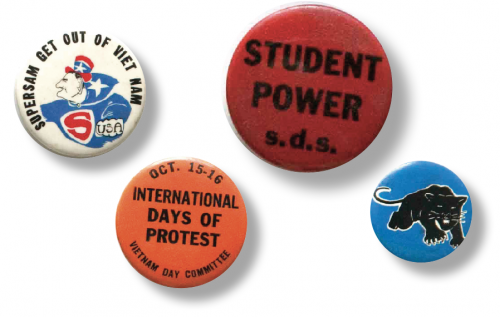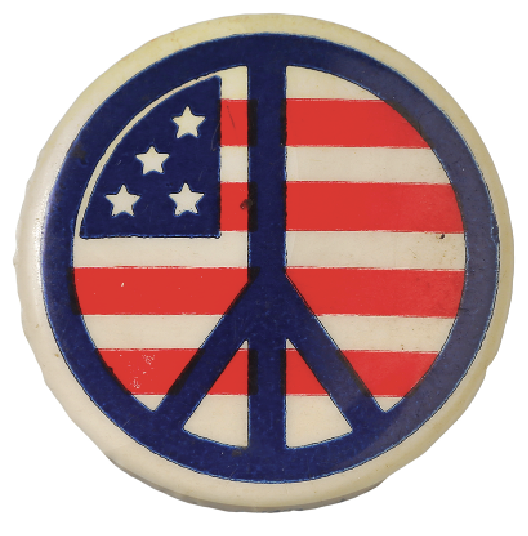‘Rabble’ Rouses Interest in 1960s Language
English professor combs archives across the country to document 1960s social movements.
‘Rabble’ Rouses Interest in 1960s Language
English professor combs archives across the country to document 1960s social movements.
Brad Lucas was born right after the Days of Rage, a 1969 spectacle in Chicago where frustrated protesters from the hippie counterculture staged a violent confrontation with police. Even though the associate professor of English was too young to understand then, the protest signaled a turning point in tone for the social change movement.

Courtesy of SDS OnLine Archives, sds-1960s.org
Around the same time, scholars were conceiving a new field, the rhetoric of social protest. Pre-1960s rhetorical analysis focused on traditional forms of public communication, such as formal speeches, said Lucas, who specializes in the academic field. “The rabble with their signs … wasn’t considered worthy.”
Television coverage in the 1960s changed the ways protesters conveyed their ideals. Scholars in rhetoric have since used the decade as a case study to expand understanding of how nontraditional political groups acquire influence over societal evolution.
Ideologies of the decade’s political groups ran the gamut from women’s liberation and racial justice to anti-imperialism and communist economics. But as wider society abandoned the groups’ causes, internal dissension flared over several points, including whether any measure of violence would be tolerated and, if so, what its limits would be.
Lucas is mapping library archives across the country to find relics of the 1960s New Left, a social movement led by college students that promoted ideals of peace and equality across races, nationalities and genders.
By working through a growing but haphazard collection of public speeches, rally flyers, crumbs of meeting notes and forgotten newspaper coverage, Lucas hopes to contextualize the New Left’s shift in messaging from nonviolent idealism to calling for physical destruction, mostly of state-owned property.

Getty Images © andykatz
Most of the professor’s research focuses on the communication strategies of two protest movements. One is the Students for a Democratic Society, a group dominated by white college students that took part in the civil rights and anti-Vietnam War movements. The other is the Black Panther Party, the mostly black group that electrified the 1960s with its anti-capitalist, anti-racist platform, social service offerings and armed protection of black communities from perceived police violence.
The Black Panthers, Lucas said, “really kind of informed and shaped the whole New Left.” For example, shortly after several Black Panthers marched around the California Capitol with loaded rifles, Students for a Democratic Society, frustrated with politicians who gave only lip service to their demands, morphed into the bomb-wielding Weather Underground.
Did the intentional change in public presentation undermine the groups’ objectives? One line of Lucas’ research examines the 1960s “declension” narrative, a popular explanation of how the transition from peaceful to warlike behavior unraveled the movement.
But the considerations around the political movements’ embracing violence were nuanced, Lucas said. “It’s not such an easy story.”
Perhaps, Lucas said, the groups were emulating South American revolutionaries. “Che Guevara was an inspirational hero for a lot of the youth of the early ’60s. Revolution was possible,” Lucas said. “And it wasn’t something that they just convinced themselves was theoretical. They actually thought they could pull it off.”
However, the story of the 1960s revolution isn’t over. Social-change movements persist, and Lucas studies them, too.
Asked what lessons he would share with today’s social-change agents, Lucas said they should consider traditional channels before taking to the streets. “Sometimes it’s effective … things like mediation, filing a complaint before grabbing the picket signs.”

Your comments are welcome
Comments
Related reading:
Mem’ries Sweet
Protesting the Library in the 1960s
The Mary Couts Burnett Library used to close on Sundays … until students waged a gentle protest.
Features
Food Justice Class Shines Light on Hunger, Nutrition
Community gardening, interviews and delivering nourishment to food deserts are all part of the curriculum.
Research + Discovery
Class Travels to U.S.-Mexico Border Wall
Justice Journey illuminates Chicano culture in Texas in conjunction with the Latino/a Civil Rights Struggles course.